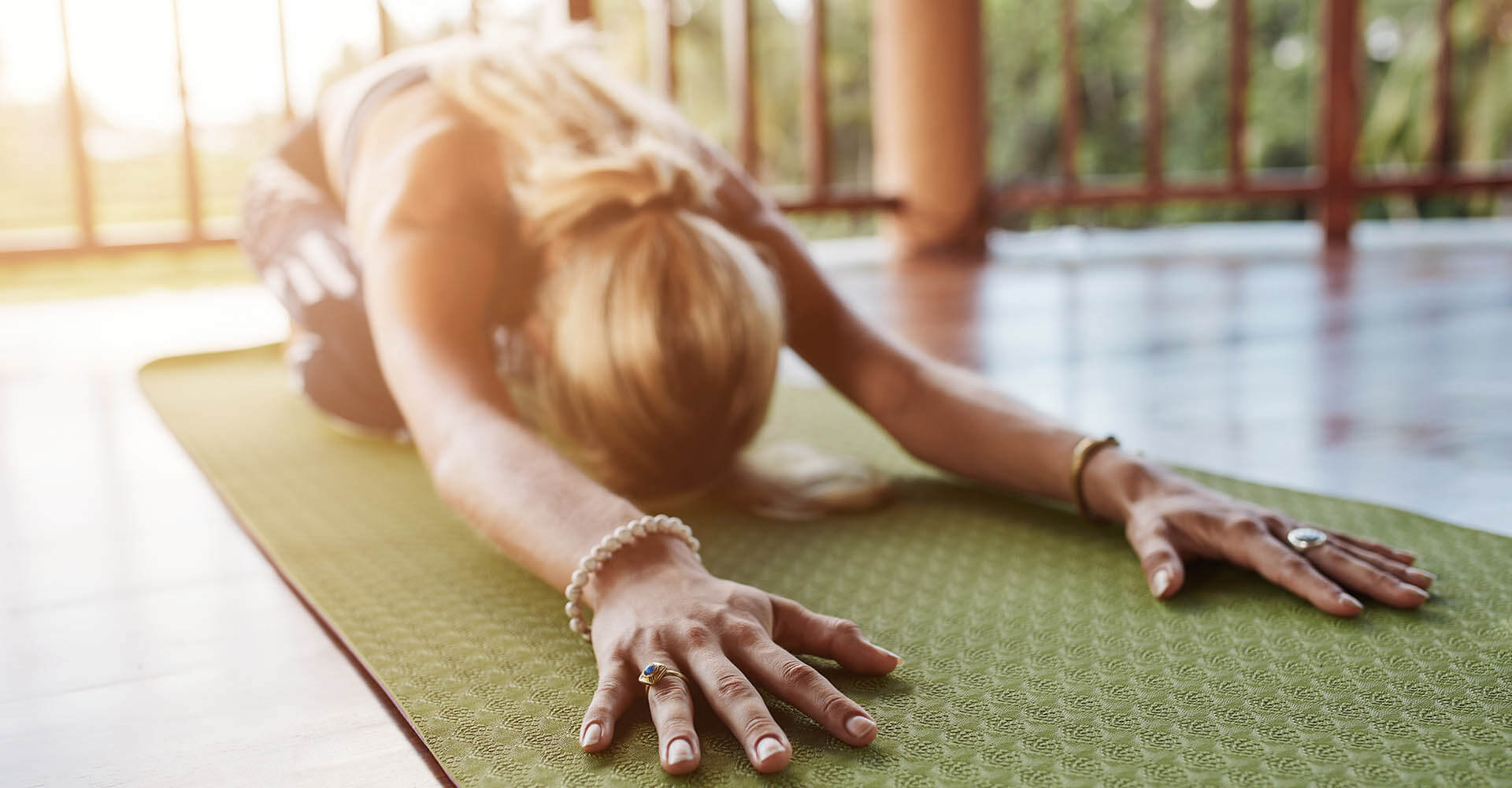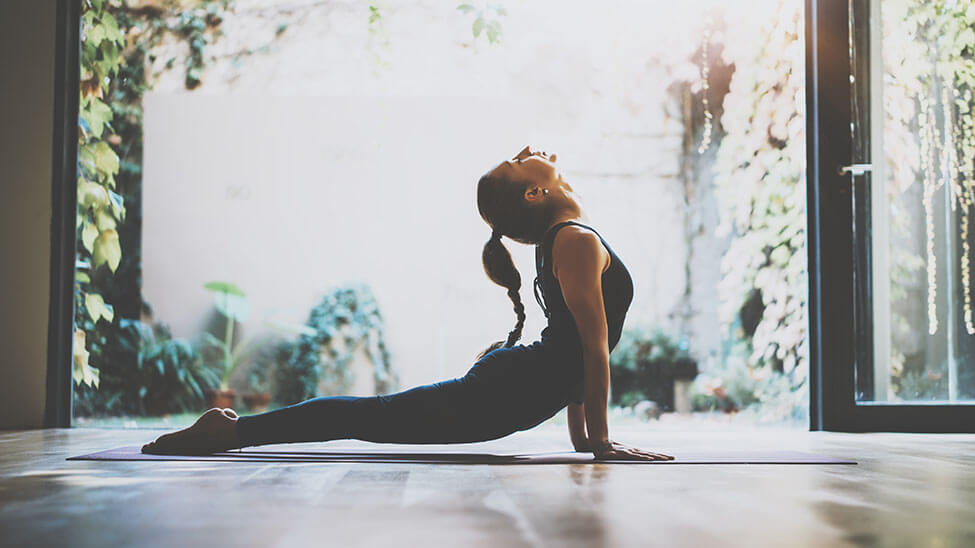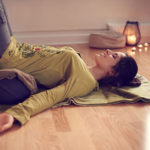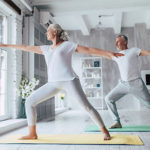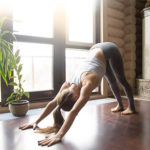
Yoga as an all-purpose weapon
Whether health problems such as back pain, circulatory disorders, obesity or mental disorders such as nervous complaints (anxiety, depression) – the philosophical teaching of yoga, which originated in India, seems to be an important helper in times of need against all our civilization and affluence diseases. This article is not intended to provide an explanation of religious backgrounds or teachings of any gurus, but to be an introduction for everyone to the modern understanding of yoga. Despite its high effectiveness, yoga makes few demands on the practitioner. You can do yoga in pairs with a partner or alone, you can practice it anytime and anywhere and you need almost no equipment. Once you start, the rest comes naturally. We’ll help you kick off the first domino now with our yoga exercises & poses for beginners.
5 Yoga exercises & poses for beginners
Start right now with our Yoga exercises & poses for beginners. Optimally, you start with a relaxation and also stop with it. In between there is a wide range of exercises with equal training of both halves of the body with accompanying and controlled breathing. The starting position is usually the “four-footed stand”. Here you form a kind of gate with the arms stretched, the back stretched horizontally and the thighs.
Cat-Cow
You are in the quadruped stand and from there you go into the back bend. In doing so, your chest is lifted and points forward. Parallel to this you inhale. This position represents the cow and now you transform into the cat by drawing the chin towards the chest and making a cat hump. This movement is accompanied by an exhalation. Repeat the transformation from cow to cat a few times.
Downward-looking dog
It continues in an animal way with the most famous exercise in yoga. We find ourselves back in the starting position. From there, we lift our knees and push our butt up until our body forms a triangle with the floor. In the triangle shape, we again consciously use our breathing while lifting one leg in its extended position. We then bend this leg and bring the foot forward to the hands as we exhale. Finally, we straighten up with our torso at our sides.
Warrior 2
From the final position of the second exercise, we spread our arms out so that they form a “T” with our torso. We take a deep breath and look purposefully over the front arm. Then we see our palm turn upward and bend backward with the back arm gripping the calf. As we do so, we exhale. The front arm is now next to the sky or ceiling in our field of vision. With a gentle swing, we move back and inhale. We repeat the same in the other direction.
Squat
In this exercise, the starting position is a little different. We sit down and pull our knees towards us so that we can enclose our knees with one arm. A straight back is especially important in this exercise. Now we turn our upper body in the opposite direction of the holding arm and place the other arm behind our buttocks. Now apply the already known breathing. After that, we turn back again by going first with our head and then with our upper body to the starting position. To keep symmetry, we do the same in the opposite direction.
Sit
The starting position is the same as in exercise 4, the only difference being the legs are extended or only slightly bent. First we hook our fingers and press our palms to the sky followed by deep breathing. Now we bend our upper body straight forward like a folding chair. At the same time, we exhale. Finally, we inhale while releasing our hooked fingers. Then we grasp our feet.
Esotericism, spirituality and yoga
Yoga has always had a certain stigma attached to it, that it is primarily practiced by “weirdos” and “hippies” who already live in a colorful world full of castles in the air. But the reality is rather that yoga is used by ordinary people like you and me to satisfy, in part, all-too-human, entirely pragmatic needs. We asked yoga teacher and trainer Sandra Amtmann to what extent you have to be spiritual to practice yoga. Here is her very insightful answer:
To start with yoga, you don’t have to be spiritual or particularly “profound”. Often, pragmatic reasons lead participants to their first yoga class: back pain, the desire for more balance or simply the need to move the body in a healthy way and not to neglect relaxation.
What can be observed, however, is that yoga works not only on a physical level, but also on a mental level. Yoga is a mindful practice that asks us to listen to our body and our breath. In addition, the mind is also integrated into the practice during the yoga exercises or in meditation. With a certain regularity and continuity of practice, this mindfulness is automatically – unconsciously or even consciously – taken from the yoga mat into everyday life. The consequence is that we begin to go through our lives, make decisions, interact with other people and the environment with this fresh mindfulness.
What I can observe with myself but also with many of my long-time yoga students or participants of my trainings and retreats is that a regular yoga practice encourages us to fully realize our own potential and enables us to live life consciously without being too caught up in the “ups and downs” of everyday life. Yoga leads us closer to our “true self” – beyond the imprints, expectations and patterns that we so easily put on ourselves or allow to be put on us.
Accordingly, yoga may be a modern form of spirituality that is free of religion and yet brings back what has been somewhat lost to us in today’s world: awareness, mindfulness, connection, community, trust – the list is endless and above all individual, because each practitioner makes their own experience and may find out for themselves how yoga works for them and what meaning yoga may have for them.
Modern Yoga
Yoga has not been bound to a religion for a long time. Therefore, anyone may practice yoga without having to sign a contract to join a world religion. Furthermore, yoga is customizable and therefore suitable for old and young, athletic and couch potato. Since yoga came to Europe in the 19th century, its character has changed a lot. Nowadays, companies all over the world offer yoga exercises during the lunch break and yoga as a way of life, which can even include vegetarian and vegan diets. Sounds complicated? It isn’t. The character of today’s yoga is much simpler than traditional yoga. But what does it bring us?
Greater health and well-being through yoga
There are several studies that confirm the positive effects on physical health. In addition to improving pre-existing medical conditions, yoga also offers prevention from a variety of diseases. A little tip: Many health insurance companies reimburse the costs of yoga classes.
Improvement of medical conditions
The wide range of movements in yoga, which often look like higher degree knots, promote blood flow to muscles, tendons, ligaments, blood and lymph vessels. This can help combat circulatory problems, for example. In addition, you can say “goodbye ever” to back and neck pain. Through the sporty aspect the musculature is strengthened and especially through the strengthening of the back muscles you will walk through life with a straight posture.
Disease prevention
You are still young and have nothing to do with diseases? Congratulations! It should stay that way. Especially in its form as a sport, yoga trains strength, flexibility, muscle endurance and sense of balance. Also the already mentioned advantages, like the straight posture thanks to strengthened back muscles, are not to be neglected. Still not convinced?
Yoga exercises as a full-fledged and challenging sport
If you tell those around you that you don’t just use yoga to meditate or relax, but integrate the exercises as a full-fledged component of your workout, it’s not uncommon to earn gloating laughter for such statements. That’s why we asked Nancy Krüger, an experienced yoga specialist and yoga teacher, about this topic. Here is her rather unambiguous commentary on it:
Traditionally, yoga has been associated with the goal of entering meditative states in order to achieve serenity. That means, originally, yogis spent most of their time just sitting. But since this was not really comfortable for the body, the yoga exercises came into being.
Today, meditation is no longer the main focus, which is why yoga is sometimes practiced as a sport. There are types of yoga such as Ashtanga or Power Yoga, where the practice is so powerful that it is equivalent to a work out. Yoga is more and more often replaced by the fitness studio and yet it is not the same.
Yoga differs from sports in the aspect of mindfulness and this has a more holistic effect on the human system. When the mind becomes present during movement and you sharpen your focus in yoga, this creates positive effects in the brain. This is often how the feeling after classical sports and a yoga class differs. Most feel much more relaxed and clearer in the head.
In short, yes yoga can be done as a sport and this quite sweaty. However, the full effect unfolds only when it integrates body and mind as a holistic system.
More energy and skills through yoga
There are also already several confirmations for the positive effects on mental health. Stress seems to play an increasingly important role in our everyday lives and people are looking for stress management. This is found in yoga.
Say “Ciao” to everyday stress
Because of the spiritual nature of yoga, many feel a release from all kinds of burdens. Through controlled breathing, yoga has a calming and balancing effect. You know this when you are stressed and get the advice to “take a deep breath”. There’s something to that. Plus, through meditation, you learn to reflect on your own behavior and make it better.
Personal development
Let’s get to the most interesting point about the benefits of yoga. A recent study by Anna Paul of the Naturopathic Clinic in Essen-Steele shows that yoga has a positive impact on action skills and mental abilities. For example, yoga boosts our creativity and concentration. As icing on the cake, yoga reduces your aging process. Who can say no to that argument?
Here’s how you can become a joga pro right away
Yoga mat
Yoga exercises & poses for beginners can be done anytime and anywhere, but it doesn’t hurt to have a soft surface. With a yoga mat or a meditation mat, the practice of yoga exercises is much more relaxed and in the end it is exactly about this relaxation.
Meditation cushion
The jogatrend has already brought forth all kinds of useful companions. For example, yoga or meditation cushions, which help you to cope with higher degree knots. In the video Miriam uses a thick towel. A yoga cushion serves the same purpose and provides great comfort. Note: Please do not fall asleep on the pillow, even if it tempts you to do so!
Yogurt
Another invention of the yoga community is the joga belt. As you could already see in Miriam’s video, this is used as an extension of the arms. So you are able to master even more unusual positions and can invent even more creative positions. Whether this belt can also score fashionably is left to the fashion experts among us.
Leggings, stretch pants or yoga pants
Attention The risk of tearing your favorite jeans during yoga exercises is not only very high, but pretty much inevitable. You’re better off opting for tear-resistant undergarments, such as yoga pants or that one pair of leggings that’s been hanging in your closet for decades and was last worn when you went to school. With the extra freedom of movement, the newly discovered yoga exercises & poses for beginners will be much easier for you.
Decoration and more
Even small gimmicks like a singing bowl or a meditation bench can get you in the right yoga mood. It doesn’t even matter if these elements are decorative or really functional when incorporated into your yoga exercises.
Let’s go!
Now you should get going. You’ve had enough input from us now, it’s time for action. Let us know how you liked this article and what you got out of it. What are your favorite exercises? What do you think of yoga as a way of life?


